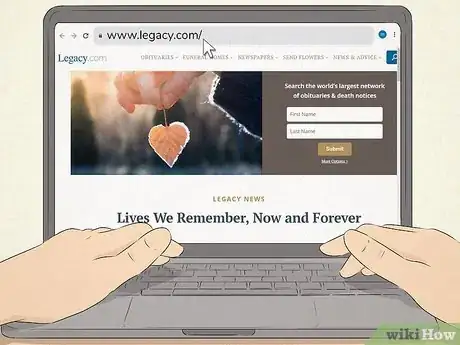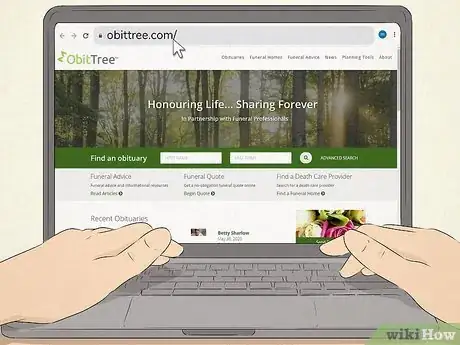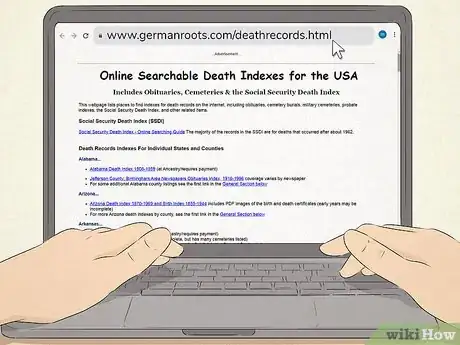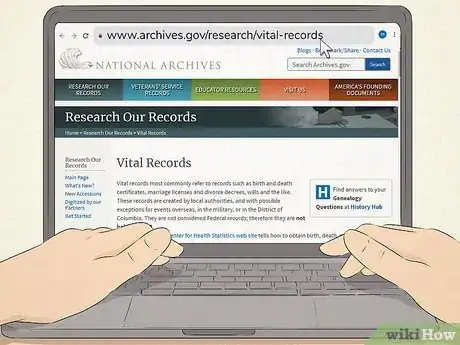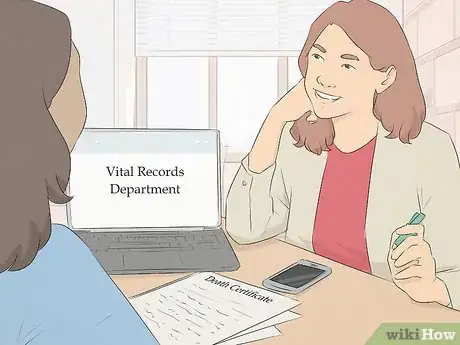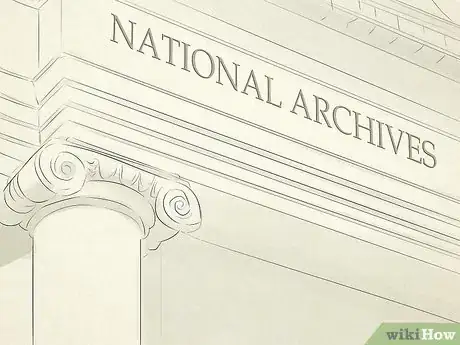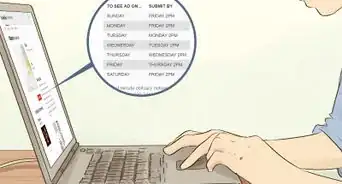This article was written by Jennifer Mueller, JD. Jennifer Mueller is an in-house legal expert at wikiHow. Jennifer reviews, fact-checks, and evaluates wikiHow's legal content to ensure thoroughness and accuracy. She received her JD from Indiana University Maurer School of Law in 2006.
There are 15 references cited in this article, which can be found at the bottom of the page.
This article has been viewed 126,662 times.
Whether you are researching your ancestry or looking for information about a specific person, you may need to find an official notice of someone's death. If you live in the United States, you can request a death certificate from your state's vital records department, but you will have to pay a fee for the copy. However, there also are plenty of ways you can find a death notice for free.
Steps
Searching Online Databases
-
1Find newspaper obituaries online. Websites such as legacy.com provide a searchable database of obituaries that previously ran in newspapers.[1]
- For example, legacy.com provides free access to obituaries from newspapers in the U.S., Canada, the United Kingdom, Bermuda, Australia, and New Zealand.[2]
- You can run a simple search with just the person's first and last name, or you can narrow your search by limiting the time, or by specifying the country and state, county, or region. Legacy.com also allows keyword searches, which could be particularly helpful if you were unsure what name was used in someone's obituary.[3]
- Legacy.com only includes obituaries as far back as February of 2001.[4]
- Websites such as WorldVitalRecords.com[5] and vitalrec.com[6] have more international death records and notices, as well as links to other sources of international vital records online. Although you can see basic information about your search results, you must subscribe to the service to gain access to the records themselves.
-
2Search for funeral home death notices. If a funeral home was used, you can find an online database of official funeral home death notices at obitsforlife.com.
- Obitsforlife.com allows you to search by name or location for death notices, or you can conduct a keyword search. In addition to funeral homes in North America, the website includes global death notices from countries such as Brazil, India, the Philippines, Japan, and the United Kingdom.
- Death notices on obitsforlife.com can only be uploaded by licensed funeral homes, so authenticity is assured. At the same time, the site's database only includes listings from funeral homes that are members of the site, so results may be somewhat limited in that respect.
Advertisement -
3Use the Social Security Death Index. Several websites such as genealogybank.com and ancestry.com allow you to search the SSDI free of charge. The SSDI contains records of people with U.S. Social Security numbers whose deaths were reported to the Social Security Administration.[7]
- Genealogybank.com has the SSDI from 1899 through 2011,[8] while ancestry.com allows you to search from 1935 through 2014.[9]
- You can search using as much or as little information about the person as you have, including first and last name, date of birth, date of death, last known residence, or Social Security number.[10]
-
4Search city or state death records. State death indexes often go back further than online obituaries or the SSDI, and many are available online for free.
- You can find links to death indexes for each state on sites such as http://www.germanroots.com/deathrecords.html and http://www.deathindexes.com.
- Although generally you can find death notices through the early 1900s for free, you may have to pay a fee or join a subscription site to gain access to older death notices, such as those from the 1700s.[11]
-
5Visit the National Archives website. The National Archives has information about vital records, including death records, and links to websites with free databases of death notices and records.[12]
- Since these records are maintained by state or local authorities, they are not federal records and not held by the National Archives. However, the National Archives website provides plenty of online research tools and other assistance for genealogists, historians, and researchers.
- The Archives does have casualty listings from the U.S. military as well as deaths of U.S. citizens in foreign countries.[13]
Using Physical Resources in Person
-
1Visit the public library. Public libraries typically have local newspapers archived, sometimes going back to the first year the newspaper was printed. Look through the newspapers to find obituary articles or other death notices.
- For example, if you go to the New York Public Library, you can look at microform copies of The New York Times going back to 1857.[14]
- If you're looking for a death notice from someone who died relatively recently, you may be able to find that online for free. However, if the person died hundreds of years ago, that information may not be digitized or available for free.
-
2Request a death certificate from the state vital records department. If you need an official death certificate, you probably will have to order it from the vital records department in the person's last state of residence.
- Typically you will be charged a fee for a standard copy and a little extra if you need a certified copy.[15]
-
3Search cemetery and burial records. Even if a gravestone is weathered or illegible, you typically can search cemetery or burial records to find details about a person's death.
- Some cemetery districts have websites where you can look up a grave online. For example, the Orange County Cemetery District provides a searchable database for graves in Anaheim Cemetery, El Toro Memorial Park, and Santa Ana Cemetery.[16] In many cases, however, you will have to make a visit to the cemetery itself to review the records.
-
4Visit your state archives. State records often go back further than Social Security or other national records and may provide more detail about the death. The state archives typically are housed in the state capital, but if you can't travel to that city you may be able to request documents through a local university research library or historical society.[17]
-
5Visit a National Archives facility. While plenty of information is available online, a visit to an Archives facility may be necessary to find the death notice you need.
- You can search the Archives website at http://www.archives.gov/locations/ to find the location nearest you and the services provided there.
- Beyond just federal records, ancestry.com also is available for free at an Archives facility, so you may be able to find the records you need there without paying a subscription fee to use the online service.[18]
References
- ↑ http://www.legacy.com/ns/
- ↑ http://www.legacy.com/ns/about/newspapers/international.aspx
- ↑ http://www.legacy.com/ns/obitfinder/obituary-search.aspx
- ↑ http://www.legacy.com/ns/obitfinder/obituary-search.aspx
- ↑ http://www.worldvitalrecords.com
- ↑ http://www.vitalrec.com/links2.html
- ↑ http://www.genealogybank.com/explore/ssdi/all
- ↑ http://www.genealogybank.com/explore/ssdi/all
- ↑ http://search.ancestry.com/search/db.aspx?dbid=3693
- ↑ http://www.genealogybank.com/explore/ssdi/all
- ↑ http://www.germanroots.com/deathrecords.html
- ↑ http://www.archives.gov/research/vital-records/
- ↑ http://www.archives.gov/research/vital-records/
- ↑ https://nypl.bibliocommons.com/item/show/11801637052907_the_new_york_times
- ↑ http://www.cdc.gov/nchs/w2w.htm
- ↑ http://www.occemeterydistrict.com
- ↑ http://www.archives.gov/research/alic/reference/state-archives.html
- ↑ http://www.archives.gov/research/databases/
- ↑ https://www.archives.gov/research/census/nonpopulation#mort
